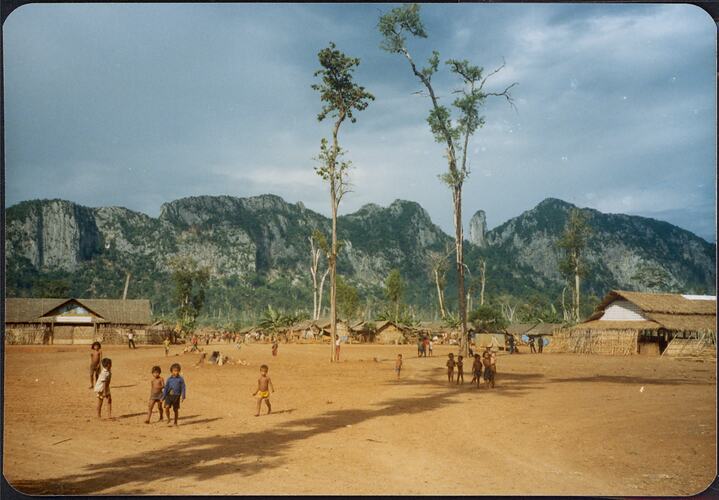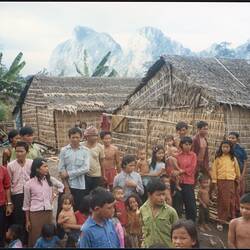Summary
Digital colour image copied from an original photograph. It portrays the Site 8 refugee camp on the border of Thailand and Cambodia, which was established for Khmer Rouge families, who were not available for resettlement by Australia and other participating receiving nations. There are some children, huts and steep mountains on Thai/Cambodia border in the distance.The photograph was taken by Australian Department of Immigration Senior Migration Officer Jennie Roberts in May 1987. Jenny visited this camp in May 1987 as part of a conference organised by Chulalongkorn University; access was usually not possible.
Jennie Roberts was posted as a Senior Migration Officer to Bangkok in Thailand from 1987 to 1989, when Australia had an extensive program for south-east Asian refugee and humanitarian entrants, primarily from Vietnam, Laos and Cambodia. Based in the Visa Office at the Australian Embassy, Jennie and her colleagues frequently travelled to UNHCR refugee camps in Thailand to interview applicants. This included visits to camps such as the Phanat Nikhom camp, 100 kilometres south east of Bangkok, which was primarily a transit camp for people already selected for relocation by Australia and other countries where they undertook orientation courses and health procedures. Other camps included the Khao I Dang camp on the Thai-Cambodian border, mainly for Kmer refugees available for resettlement. The staff were responsible for deciding temporary and permanent visa applications, also including people from Burma and Bangladesh.
Most of Jennie's work during her two year posting was associated with the Refugee and Special Humanitarian Programs (RSHP) in Thailand and the Vietnam Family Migration Program (VFMP) in Vietnam. The VFMP was implemented to reunite families in Vietnam with relatives who had fled Vietnam after 1975. These were people who remained in temporary asylum in various south-east Asian countries or who had arrived in Australia by boat.
Description of Content
View of refugee camp in distance with mountains in background and people in middle distance.
Physical Description
Digital image.
Significance
This important and rare collection of photographs and craft represents two sides of the asylum experience - the refugees and the government officials. These parallel and intersecting experiences have both personal and bureaucratic elements to them, linked by place, and world events, with craft and a gift of appreciation providing tangible points of connection and memory. The experiences of migration officials are frequently untold and unrepresented by material culture, as are material manifestations of refugee narratives. This collection enables the telling of both stories, with primacy given in this instance to the employee as custodian of the objects. The photographs provide an insight into refugee camp life for both residents and workers through the eyes of an Australian immigration official. The collection is also a symbol of a particular period in Australian migration history when support for refugee programs had both bipartisan and public support. Finally the theme of refugee, internee and detainee craft recurs across time and place and provides a tangible connection between very different human experiences, the trauma, economy and the tedium of which has been consistently alleviated through artistic practice.
More Information
-
Collecting Areas
-
Acquisition Information
Donation from Jennie Roberts, 18 Jun 2012
-
Photographer
Ms Jennie Roberts - Department of Immigration, Local Government and Ethnic Affairs, Thailand, May 1987
-
Format
Digital file, Colour
-
Classification
Migration, Processing - immigration selection, Refugee camps
-
Category
-
Discipline
-
Type of item
-
Keywords
Prostheses, Artistic Practices, Crafts, Immigration, Refugees, Immigration Selection, Vietnamese Immigration, Prosthetics, Vietnam War Refugees

